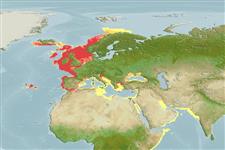Common names from other countries
Classification / Names / Names
Namen | Synonyme | Catalog of Fishes (gen., sp.) | ITIS | CoL | WoRMS
Environment: milieu / climate zone / depth range / distribution range
Ökologie
; brackwasser; tiefenbereich 0 - 521 m (Ref. 108343). Temperate; 72°N - 12°N, 19°W - 62°E
Western Indian Ocean, Northeast Atlantic and the Mediterranean. Subtropical.
Length at first maturity / Size / Gewicht / Alter
Maturity: Lm ? range ? - ? cm Max length : 2.5 cm SHL Männchen/unbestimmt; (Ref. 7882)
Species' maximum length from the Belgian part of the North Sea (Ref. 7882). Inhabit sandbanks and inshore areas (Ref. 96352). Common in near-coastal zone, rarely further than 30 km off the coast. Found buried deep in almost all sediment types but prefer fine-grained to muddy substrates; rare in coarse substrates. Feeds through its long, individually separated and stretchable siphons (Ref. 7882). Known as a surface deposit feeder (Refs. 96214, 96292).
Life cycle and mating behavior
Geschlechtsreife | Fortpflanzung | Ablaichen | Eier | Fecundity | Larven
Members of the class Bivalvia are mostly gonochoric, some are protandric hermaphrodites. Life cycle: Embryos develop into free-swimming trocophore larvae, succeeded by the bivalve veliger, resembling a miniature clam.
Degraer, S., J. Wittoeck, W. Appeltans, K. Cooreman, T. Deprez, H. Hillewaert, K. Hostens, J. Mees, E. Vanden Berghe and M. Vincx. 2006. (Ref. 7882)
IUCN Rote Liste Status (Ref. 130435)
CITES Status (Ref. 108899)
Not Evaluated
Not Evaluated
Nutzung durch Menschen
| FishSource |
Tools
Internet Quellen
Estimates based on models
Preferred temperature
(Ref.
115969): 6.7 - 13.1, mean 8.8 (based on 495 cells).
Widerstandsfähigkeit
hoch, Verdopplung der Population dauert weniger als 15 Monate. (K=1.22).
Verwundbarkeit
Low vulnerability (10 of 100).
Preiskategorie
Unknown.
